174 Search Results for prompt
July 21, 2012
by Robin Parker -
A ‘funny area’ is not a technique or strategy you will see in a behavior or speech-language therapy text-book. But here is how we came to know and love ‘funny time’ & the ‘funny area’ A Little Background Tommy, a 9-year-old boy, seemed to be getting the ‘giggles’ each session. The graduate student clinician was not sure how to ‘control the situation’. Tommy typically worked hard using his Vantage Lite to build long and complex sentences for communication during natural age-appropriate activities (i.e., golf, art, and reading). But then the ‘giggles’ would start… and less and less communication was getting done. Initially, the clinician spent time redirecting Tommy. She would have him sit straight, pay more attention, and re-focus, but in the long run it would be more about what the clinician wanted then about Tommy communicating. We prompted the graduate student to think about how more could be accomplished,... [Read More...]
June 26, 2012
by Carole Zangari -

SLPs love to talk, of course, but sometimes that works against us. Over-prompting. Jumping in to repeat the last question. Re-phrasing the previous comment. Nature abhors a vacuum and sometimes we just can’t stop ourselves. What makes us fun at parties, though, can make it difficult for our AAC friends to become active, assertive communicators. Too much verbiage on our part can really slow down the journey toward communicative independence. We know better. We really do. But sometimes we need a little help to remind ourselves. And, so, a few reminders to us all… 1. Make the expectations clear using visual supports and aided language input. 2. Create a motivating context in which the learner needs to communicate in order to get his/her own agenda met. 3. Pause. Look expectantly at the communicator. Pause some more. Look even more expectant. 4. Keep pausing. Use a gesture for emphasis (e.g., cup... [Read More...]
June 24, 2012
by Carole Zangari -
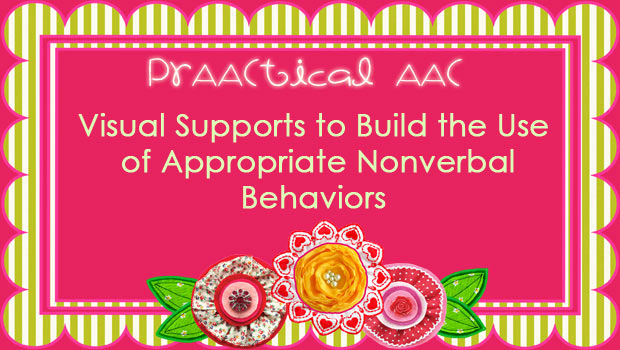
Most of our posts are about teaching language, but today we take a little side trip into nonverbal communication. We’ve all worked with folks who have difficulty maintaining appropriate distance and making eye contact, and know how problems in these area can really impede a person’s ability to relate well to others. Our video for this week, from Autism Teaching Strategies, illustrates how to use pictures supports to teach appropriate nonlinguistic conversational behaviors. – Of course, we were drawn to it because of our own experience that using pictures as a reminder is much easier to fade than oral language prompts (e.g., ‘Don’t forget to look at me when you talk;’ ‘Quiet hands’). – What we also love about this video is the teaching strategy: role reversal. In this strategy, the SLP (or teacher/parent) provides a model of both positive and negative examples of the target skill. The learner’s job... [Read More...]
June 16, 2012
by Carole Zangari -

This month we’ve been talking about ways to use traditional language facilitation strategies with people who use AAC. So far, we’ve covered expansion and extensions and recasts. This week we talk about feedback. Feedback is a critical component of any learning experience. It functions as a signpost and let’s us know where we are relative to our destination. Let’s think about how we can use it to improve the language of people who use AAC. – Contingent Responses What we do and say after the AAC learner communicates can be a powerful way to impact patterns of language use. The cardinal rule in AAC intervention is to provide consequences that are contingent on what was communicated. So, if the beginning AAC learner requested a something they don’t really like by mistake, we’d still provide that item and have them interact with it briefly before giving them a chance to make a different choice.... [Read More...]
May 15, 2012
by Carole Zangari -
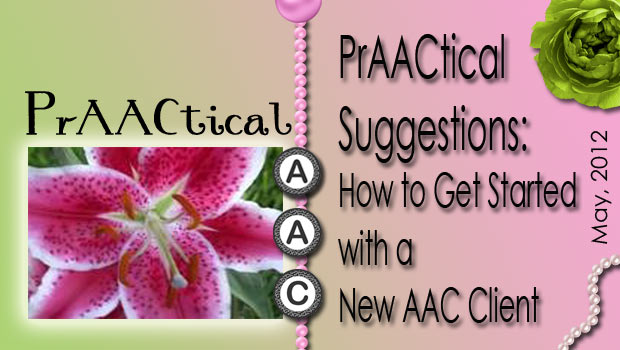
– This is the first week of a new semester for us, and that means we get the pleasure of introducing a new crop of student SLPs to clients with AAC needs. We’ve been busy looking at lesson plans, discussing goals and objectives, listening to ideas for therapy activities, and helping to develop plans for data collection. With those recent conversations buzzing in our ears, here are some thoughts about getting AAC therapy sessions off to a good start. – 1. Connect with the client and family before the first session. Take some time to plan out questions that will help you get to know their expectations, family culture, and daily routine. 2. Know the history. Go beyond the diagnosis and device. Take time to research what’s been done before, how that worked out, and, if you can, how that was perceived. Knowing where the client has been on his/her... [Read More...]
May 13, 2012
by Robin Parker -
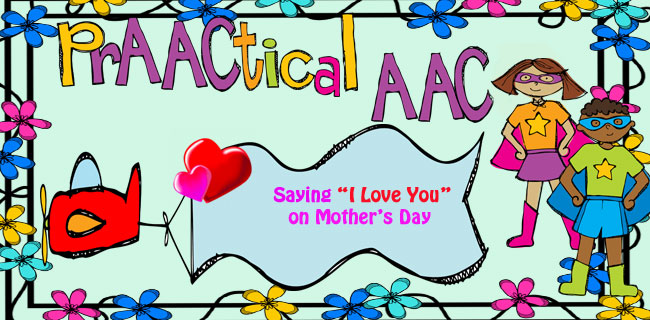
Saying “I Love You” is very important to most moms (and dads), especially on Mother’s Day (& Father’s Day). I never need to receive a mother’s day present from my son….. he is my present….. he was born on Mother’s Day (18 years ago). I feel like he is my never-ending perfect gift. He says “I love you” often, even at 18. So mixing this sentiment with my work, it saddens me to hear people say, my daughter does not “talk”, I only wish she could say “I love You“. I have learned that with AAC strategies, ALL children can say “I love you”. Here are some ways to help children (adults) ‘say’ it more often, in a conventional way, and so everyone can hear it. Record “I Love You” on a one hit message device/card/picture (Record with #1- your child’s voice, #2 same aged matched peer, or #3... [Read More...]
April 30, 2012
by Robin Parker -
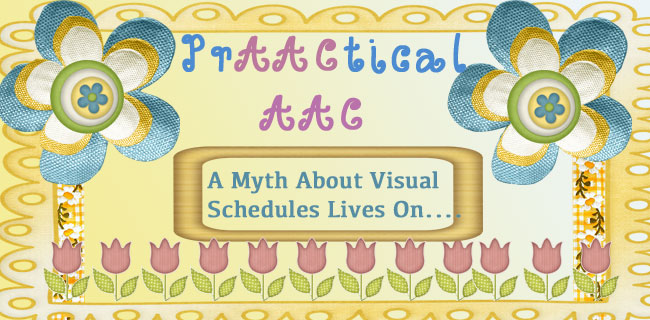
Nooooo, not again. A myth about visual schedules continues to rear its ugly head in a prAACtical situation (maybe we can reframe it into a learning opportunity??). Some history- A parent of twin girls with autism (age 15 and two other younger children– yes total 4) stopped by our office to pick up some autism awareness materials yesterday (a super busy mom in so many ways —going out of her way to help our community). As we were exchanging pleasantries and getting updates on how the girls were doing, we heard something that continues to surprise us–(and not in a good way). What did we hear? We heard that the girls were doing relatively well (not the surprising comment) but that mom was extra busy because the girls were no longer independent in taking their showers. They could do it by themselves but didn’t like the sensory input of soap... [Read More...]
April 22, 2012
by Carole Zangari -

Transitions can be hard for everyone, whether it is turning off the TV to finish grading papers or leaving a favorite place to go run some errands or following through to finish cleaning out the garage. For people with significant communication difficulties, there can be additional challenges. Here are some of our favorite tools and strategies for making transitions easier for everyone. – Visual Schedules: Our hands-down favorite way of helping people transition smoothly is to make the expectations visual and explicit. Lots of info on making this strategy successful here and here. Timers, timers, and more timers! We love them because, once the routine and expectations are established, they work so beautifully in so many situations. Social stories:Well-written social stories shared via high quality intervention can go a long way in preventing or minimizing transition issues. Transition items: Lots of families, teachers, and SLP have had success using objects... [Read More...]
April 14, 2012
by Carole Zangari -
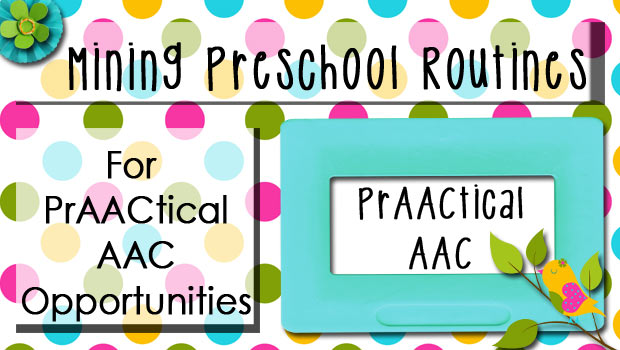
Meet Jenna, a spirited little girl with developmental delays who is learning to communicate using multiple modalities. Follow her along this morning as she goes to her preschool and gets dozens of opportunities to practice the AAC skills she is learning. 101 opportunities to practice target skills before lunch? It’s a piece of cake with this well-oiled preschool team! Jenna’s communicative functions are noted in CAPS and her communication modalities are in italics. – Let’s watch and see how Jenna is getting all that practice in as she goes about her day. – 7:55 1. Enter the building, pause at a trained adult communication partner (receptionist) for Jenna to GREET with a vocalization and wave 2. ANSWER a social question (“How are you?”) with gesture (thumbs up) 3. Say GOODBYE with a wave 4. Once in the classroom, repeat GREETINGS with teacher, aide, and a friend. 5. ASK for HELP putting... [Read More...]
March 24, 2012
by Carole Zangari -
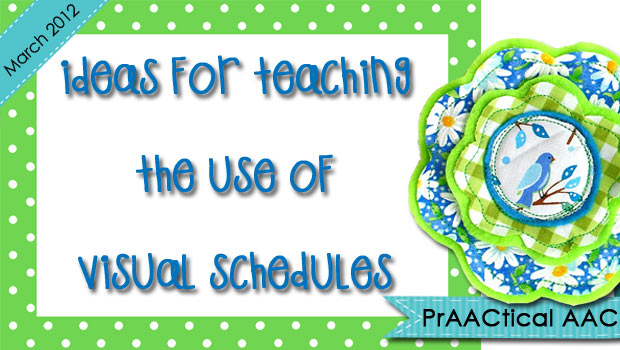
There’s nothing more depressing to us than walking into a classroom in the spring and seeing pristine visual schedules. Why? Because it probably means that the students aren’t really using them. We cheer when we see schedules that are rumpled and dog-eared, not shiny. Show me a battered and tattered visual schedule, and I’ll show you one that gets used every day. Sadly, that’s not always the case. – The bridge between having a visual schedule and consistently using it is one that many learners don’t seem to cross. Here are some of our ideas for helping your AAC learners to the other side. – 1. Have a plan to teach the schedule. If you are working one-on-one with a learner, you can easily implement the schedule and get them using it with most-to-least prompting. If you’re working with a group or a classroom, consider staggered implementation. Teaching 12 beginners... [Read More...]








